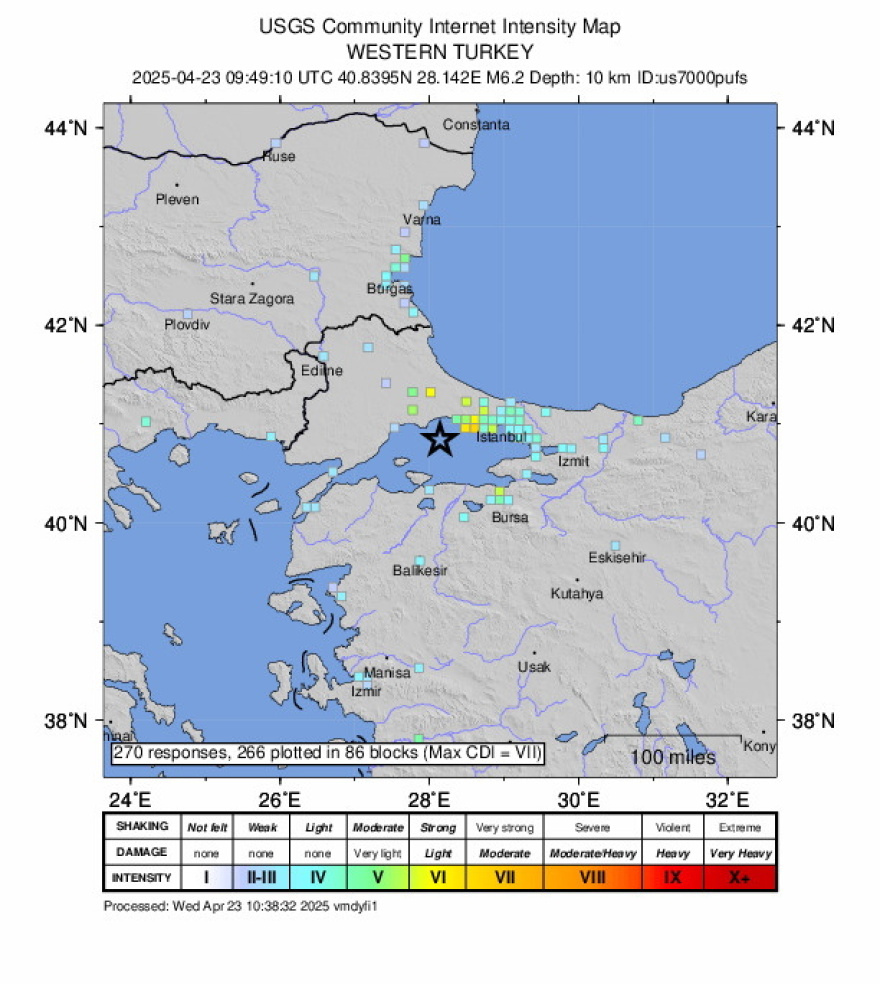Turkish seismologists are puzzled by the ongoing seismic activity in the Istanbul and Marmara Sea region following the powerful 6.2-magnitude earthquake on Wednesday, April 23.
Notable seismologists, including the well-known Naji Giorur, have suggested that this earthquake could be a “precursor” to the anticipated major quake of 7.2 magnitude, which is expected to release tenfold, or possibly even more, energy compared to the recent tremor.
Seismologists categorize the northern branch of the northern Anatolian fault, which runs through the Sea of Marmara, into three segments. The eastern segment was responsible for the 7.4-magnitude earthquake in the Gulf of Nicomedia in 1999, while the western segment, extending to the Gulf of Xeros in Eastern Thrace, experienced a similar quake in 1912. The central segment, which was dormant, gave rise to the April 23 event.
Experts caution that the fault line extending eastward, connected to the 1999 earthquake, remains intact. They note that the April 23 quake is generating stresses that could lead to another significant earthquake once they reach a critical threshold.

Seismologists are still anticipating a major earthquake exceeding 7.0 magnitude, pointing out that the eastern extension of the fault that caused the recent quake, located south of central Istanbul, remains unbroken and is still gathering energy. Thus, the April 23 earthquake is adding tension, bringing us closer to the predicted larger quake.
Professor Naji Giorur emphasizes, “This is not the major quake we expect. The tension on the fault is subsiding. The true earthquake will be stronger, exceeding 7 on the Richter scale.” In a recent post, he stated, “The Istanbul earthquake (Marmara earthquake) will occur, and the recent earthquakes of April 23 have brought it even closer.”
Professor Okan Touisuz from Istanbul Technical University maintains that a significant earthquake in the Sea of Marmara is still anticipated. “Since the major quake of August 17, 1999, there has been a 15% transfer of stress in this already active zone, and this has brought the expected earthquake closer,” he noted.
Most seismologists agree that a gradual evolution in seismic activity is occurring, and that the 6.2-magnitude event is part of a sequence that began with a 5.8-magnitude quake in 2019.
Conversely, some seismologists are more optimistic, arguing that the 6.2 quake may be a significant release of accumulated energy from a fault that hasn’t seen a major earthquake in over 250 years.
Professor Sener Usumezzoi, known for predicting the 1999 quake, stated a few weeks ago that he expected a quake in the 6-6.5 magnitude range in the area where the recent tremor occurred. Following the quake, he remarked, “The Marmara earthquakes are over. Rest easy.” He insisted that “the anticipated Marmara earthquake has happened and no more major quakes are expected,” criticizing colleagues who suggest a major Istanbul quake is imminent. “From now on, earthquakes will be ‘quiet.’ I know the Sea of Marmara like the back of my hand,” he affirmed.
Professor Osman Bektas reassures, “There is no reason for concern. Aftershocks may occur, but we do not anticipate a larger earthquake, as the fault has released this much energy.”
Professor Ovgyun Ahmed Ercan offers a balanced view, stating, “The energy released was equivalent to that of the Hiroshima bomb. I indicated earlier that before the main 7.2-magnitude earthquake, there would be events of around 6 magnitude. This is one of them.” However, he estimates that a very strong earthquake is likely more than 20 years away, saying, “This was not the significant Istanbul earthquake we anticipated. We still have time; I don’t believe it will happen before 2045 or 2065.”
Ask me anything
Explore related questions















